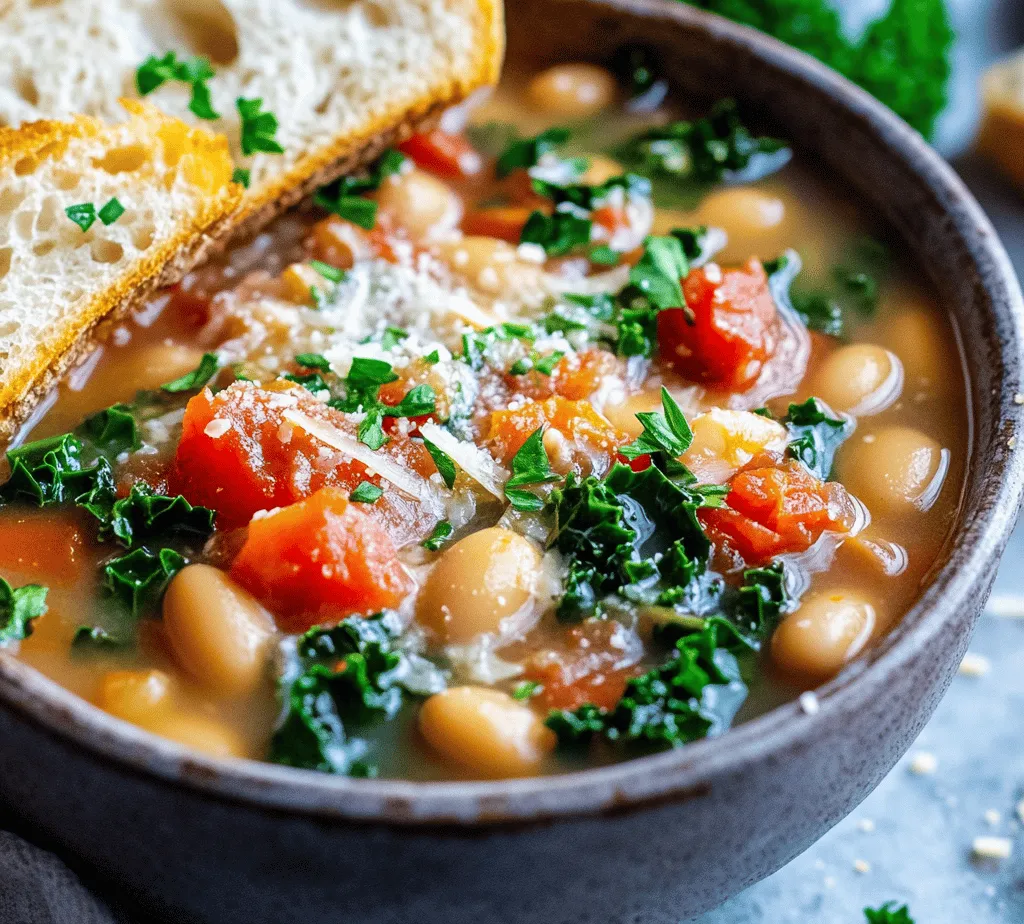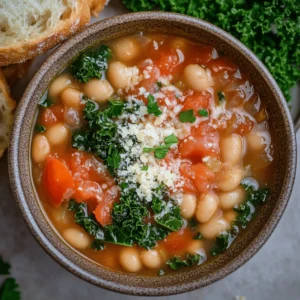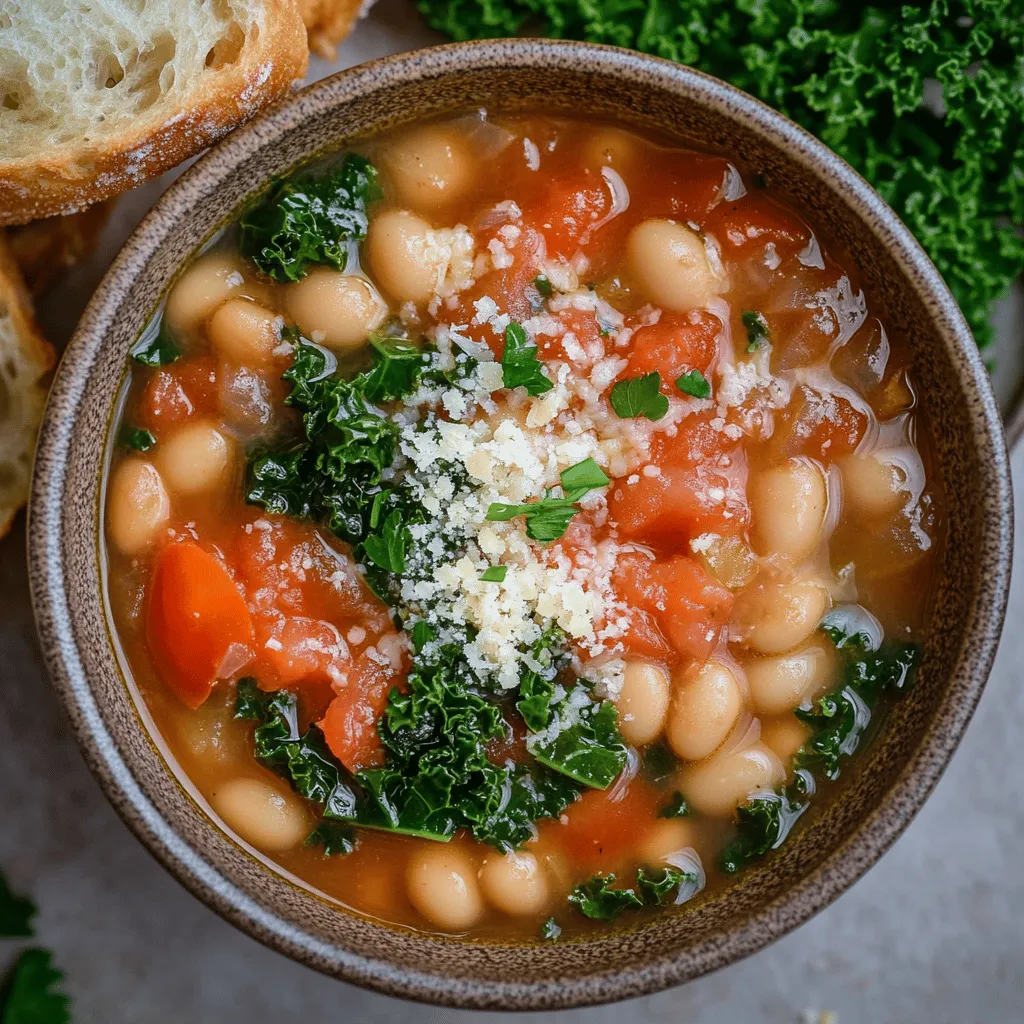Tuscan White Bean Soup is a delightful dish that brings the rustic charm of Italy right into your kitchen. Originating from the sun-kissed hills of Tuscany, this soup embodies the essence of Italian cuisine—simple, wholesome ingredients coming together to create something extraordinary. Tuscan cuisine, celebrated for its emphasis on fresh, local produce and bold flavors, has made this white bean soup a staple across Italian households and restaurants alike.
This comforting soup is not only a delicious meal but also a testament to the Italian philosophy of “cucina povera,” or “poor kitchen,” where humble ingredients are transformed into nourishing dishes. Made with dried cannellini beans, vibrant vegetables, and fragrant herbs, Tuscan White Bean Soup is a nourishing option that warms both the body and soul.
Health Benefits of White Beans
White beans, particularly cannellini beans, are the stars of this recipe. Rich in plant-based protein, fiber, and essential nutrients, they are an excellent choice for anyone looking to maintain a balanced diet. The fiber content in white beans aids digestion and helps keep you feeling full longer, making this soup a great option for those watching their weight. Additionally, these beans are packed with vitamins and minerals such as iron, magnesium, and potassium, which can contribute to overall health.
The combination of fresh vegetables like onions, carrots, and celery not only enhances the flavor but also boosts the nutritional profile of the soup. With the inclusion of leafy greens such as kale or spinach, this dish becomes a powerhouse of vitamins A, C, and K, as well as antioxidants that can support your immune system. Whether you are looking for a cozy meal on a chilly day or a nutritious dish to serve your family, Tuscan White Bean Soup delivers on all fronts.
Setting the Stage for Your Soup
This article will serve as a comprehensive guide to making delicious Tuscan White Bean Soup from scratch. We will explore the essential ingredients, preparation methods, and tips for building a rich flavor profile that will elevate this simple soup into a culinary delight. Whether you are a seasoned cook or a beginner in the kitchen, this recipe is approachable and rewarding.
Understanding the Ingredients
To create the perfect bowl of Tuscan White Bean Soup, you must first familiarize yourself with the key ingredients that will bring this dish to life.
Key Ingredients Overview
1. Dried Cannellini Beans: The heart of this soup, cannellini beans are large, white kidney beans that have a creamy texture and a nutty flavor. They absorb the flavors of the soup beautifully, making them the ideal choice for this recipe.
2. Fresh Vegetables: A classic mirepoix of onions, carrots, and celery forms the aromatic base of the soup. These vegetables provide depth and complexity to the flavor profile.
3. Garlic: Often referred to as the soul of Italian cooking, garlic adds a robust flavor to the soup. It is essential to incorporate it at the right stage of cooking to maximize its aromatic qualities.
4. Herbs and Spices: Fresh herbs such as rosemary and thyme, along with a bay leaf, are crucial for infusing the soup with flavor. These herbs evoke the scents of the Italian countryside and complement the earthiness of the beans.
5. Leafy Greens: Adding kale or spinach not only enhances the nutritional value of the soup but also adds a vibrant color and texture.
6. Parmesan Cheese: While optional, a sprinkle of freshly grated Parmesan cheese adds a savory richness to the finished dish, rounding out the flavors beautifully.
Nutritional Benefits of Cannellini Beans
Dried cannellini beans are a major player in this recipe, and for good reason. Not only do they impart a creamy texture when cooked, but they are also a fantastic source of protein, making them an excellent choice for vegetarian and vegan diets. In fact, just one cup of cooked cannellini beans provides approximately 15 grams of protein and 13 grams of fiber, making them a filling and satisfying ingredient.
Furthermore, cannellini beans are low in fat, cholesterol-free, and rich in antioxidants, which can help protect the body from harmful free radicals. They are also a good source of folate, which is essential for cell division and overall health. Incorporating these beans into your diet can contribute to heart health, improve digestive function, and promote stable energy levels throughout the day.
The Role of Fresh Vegetables
Using fresh vegetables in your Tuscan White Bean Soup is imperative for achieving the best flavor. Onions provide a sweet and savory base, while carrots add a hint of natural sweetness. Celery contributes a refreshing crunch and enhances the overall aroma of the soup. Each vegetable plays a vital role in creating a balanced flavor profile, ensuring that every spoonful is rich and satisfying.
Herbs and Spices: Enhancing Flavor Development
The right combination of herbs and spices can elevate your soup, giving it the authentic Tuscan flavor that makes it so beloved.
– Rosemary: This aromatic herb is synonymous with Italian cooking. Its earthy, pine-like flavor pairs perfectly with the creaminess of the cannellini beans.
– Thyme: Another essential herb, thyme adds a subtle depth that complements the other ingredients without overpowering them.
– Bay Leaf: This often-overlooked ingredient infuses the soup with a complex flavor that develops as it simmers. Remember to remove it before serving, as it is not meant to be eaten.
When using herbs, consider using fresh varieties whenever possible, as they impart a brighter, more vibrant flavor compared to dried herbs.
Nutritional Value of Leafy Greens
Incorporating leafy greens, such as kale or spinach, not only adds a splash of color to your soup but also significantly boosts its nutritional value. Kale is a nutrient-dense superfood, rich in vitamins A, C, and K, along with minerals like calcium and iron. Spinach, on the other hand, is known for its high levels of folate and antioxidants, which can help reduce inflammation and support overall health.
Adding these greens to your soup not only enhances its health benefits but also provides a delightful texture contrast to the creamy beans.
Optional Parmesan Cheese
While Parmesan cheese is an optional addition to Tuscan White Bean Soup, it can make a world of difference in terms of flavor. The nutty, salty notes of freshly grated Parmesan complement the earthiness of the beans and the freshness of the vegetables, creating a harmonious blend of tastes. When adding Parmesan, be sure to use high-quality cheese for the best results.
Preparation Methods
Now that you are familiar with the key ingredients for your Tuscan White Bean Soup, it’s time to explore the preparation methods that will ensure your soup is flavorful and satisfying.
Soaking the Beans
Soaking dried beans is a crucial step that enhances their texture and digestibility. By soaking the beans, you help reduce cooking time, allowing them to cook evenly and thoroughly. Moreover, soaking helps remove some of the indigestible sugars that can lead to bloating, making for a gentler experience on your stomach.
Step-by-Step Guide to Soaking Dried Beans
1. Measure the Beans: Start by measuring the desired amount of dried cannellini beans. A typical serving size is about 1 cup of dried beans, which will yield approximately 2-3 cups of cooked beans.
2. Rinse the Beans: Place the beans in a colander and rinse them under cold running water to remove any dirt or debris.
3. Soak the Beans: Transfer the rinsed beans to a large bowl and cover them with at least 3 inches of water. Allow them to soak for 6-8 hours or overnight.
4. Drain and Rinse Again: Once soaked, drain the beans and rinse them again under cold water to remove any remaining impurities.
Quick Soaking Method
If you’re short on time, you can use a quick soaking method:
1. Rinse the beans as described above and place them in a pot.
2. Cover the beans with water and bring to a boil.
3. Boil for 2-3 minutes, then remove from heat and let them soak in the hot water for 1 hour.
4. Drain and rinse before cooking.
Cooking the Beans
After soaking, it’s time to cook the beans to perfection. Properly cooked beans will be tender but still hold their shape, adding to the overall texture of the soup.
Instructions for Boiling and Cooking Beans
1. In a Pot: Place the soaked and rinsed beans in a large pot and cover them with fresh water. Use a ratio of about 3 cups of water for every 1 cup of soaked beans.
2. Bring to a Boil: Bring the pot to a gentle boil over medium-high heat.
3. Simmer: Once boiling, reduce the heat to low, cover, and let the beans simmer for about 60-90 minutes, or until they are tender.
4. Check for Doneness: Periodically check the beans for doneness, adding more water if necessary to keep them submerged.
5. Season: Add a pinch of salt during the last 10-15 minutes of cooking to enhance the flavor of the beans.
Using Canned Beans for a Quicker Alternative
If you’re pressed for time or prefer a more convenient option, using canned cannellini beans is a great alternative. Simply rinse and drain the beans before adding them directly to the soup during the cooking process. Canned beans are already cooked, so you can skip the soaking and boiling steps while still achieving a delicious soup.
Building the Flavor Profile
Creating a rich and flavorful Tuscan White Bean Soup involves layering flavors through careful preparation. One of the essential steps in this process is sautéing the vegetables.
Sautéing the Vegetables
Sautéing is a cooking technique that involves cooking food quickly in a small amount of fat over relatively high heat. This method is particularly important for developing the base flavors of your soup.
1. Heat the Oil: In a large pot or Dutch oven, heat a couple of tablespoons of olive oil over medium heat.
2. Add the Mirepoix: Once the oil is shimmering, add the chopped onions, carrots, and celery. Sauté the mixture for about 5-7 minutes, or until the vegetables are softened and the onions are translucent.
3. Texture and Flavor Balance: The key to a successful sauté is to avoid overcrowding the pan, as this can lead to steaming instead of sautéing. If your pot is too small, consider cooking the vegetables in batches.
Incorporating Garlic and Herbs
Adding garlic and herbs at the right stage of cooking is crucial for maximizing their flavors.
1. Add Garlic: Once the mirepoix is softened, stir in minced garlic and sauté for an additional 1-2 minutes. Be careful not to let the garlic burn, as it can turn bitter.
2. Add Herbs: After the garlic becomes fragrant, add your fresh rosemary, thyme, and a bay leaf. Sauté for about 1 minute to release their essential oils and enhance the soup’s flavor.
By following these steps, you’ll create a solid foundation for your Tuscan White Bean Soup, ensuring that each bite is packed with flavor and comfort.
In the next section, we will dive deeper into the process of bringing all these elements together to create a soul-warming bowl of soup that captures the essence of Italian cuisine. Stay tuned as we explore the next steps in crafting this delightful dish!

Creating the Soup Base
To craft a delicious Tuscan White Bean Soup, the soup base serves as the foundation for all the flavors to develop and meld together beautifully. The combination of aromatic vegetables and herbs is crucial, enhancing the overall aromatic qualities of the dish. Fresh herbs such as rosemary and thyme not only add depth but also bring a fragrant essence that’s quintessential to Tuscan cuisine.
Combining Ingredients
Begin by gathering your prepared ingredients: the sautéed onions, carrots, and celery. Once these vegetables have softened and released their natural sweetness, it’s time to build the soup’s base.
Step-by-Step Process for Adding Broth and Tomatoes
1. Pour in about 6 cups of vegetable or chicken broth. The broth is essential as it forms the liquid backbone of the soup, providing moisture and flavor.
2. Next, add 1 can (14.5 ounces) of diced tomatoes, including their juices. The tomatoes introduce a subtle acidity and sweetness that help balance the richness of the beans and the earthiness of the herbs.
3. Stir the mixture well to combine all ingredients evenly.
Importance of Simmering to Meld Flavors Together
After adding the broth and tomatoes, bring the soup to a gentle boil over medium-high heat. Once boiling, reduce the heat to low. Cover the pot and allow the soup to simmer for about 20 minutes. This simmering process is crucial, as it allows the flavors to meld together, creating a harmonious base that will enhance the overall taste of the soup.
Adding Beans and Greens
Now that the soup base is simmering and aromatic, it’s time to introduce the star ingredients: the beans and greens.
1. Open and rinse 2 cans (15 ounces each) of cannellini beans, draining and rinsing them under cold water to remove excess sodium and starch. Cannellini beans are creamy and packed with protein and fiber, making them an ideal choice for this soup.
2. Add the rinsed beans to the pot, stirring gently to combine them with the soup base.
3. Next, add 2 cups of chopped kale or Swiss chard. These greens not only add vibrant color but also contribute essential vitamins and minerals.
Simmering Time for Flavor Development
Cover the pot again and let the soup simmer for an additional 10-15 minutes. This step is vital for the greens to wilt and soften, while the beans heat through and absorb the flavors of the broth. Stir occasionally to ensure even cooking and prevent sticking.
Final Seasoning and Serving Suggestions
With the soup simmered to perfection, it’s time to make those final adjustments and prepare for serving.
How to Taste and Adjust Seasonings for the Perfect Balance of Flavors
Before serving, taste the soup and adjust the seasonings as needed. You may find that a pinch of salt or a dash of freshly ground black pepper enhances the flavors further. Remember, seasoning is subjective; start with small amounts and build up to your preferred taste.
Exploring the Addition of Lemon Juice for Brightness
Just before serving, squeeze in the juice of half a lemon. This addition brightens the soup and enhances the depth of flavors, cutting through the richness of the beans and adding a refreshing element. The acidity from the lemon balances the dish, making it feel lighter and more vibrant.
Serving the Soup
Presentation can elevate your dining experience, and there are several ways to serve your Tuscan White Bean Soup.
1. Garnishing: Ladle the soup into bowls and garnish with freshly chopped parsley for a pop of color and freshness. A sprinkle of grated Parmesan cheese adds a savory, umami touch that complements the soup beautifully. For a vegan option, consider using nutritional yeast for a cheesy flavor without dairy.
2. Side Dishes: Pair the soup with a slice of crusty bread, such as a rustic sourdough or a baguette. The bread is perfect for dipping and scooping, adding to the overall enjoyment of the meal. A simple side salad dressed with olive oil and vinegar can also enhance the dining experience, providing a crisp contrast to the warm soup.
Nutritional Benefits of Tuscan White Bean Soup
Tuscan White Bean Soup is not only comforting but also packed with nutritional benefits that make it a wholesome meal option.
Overview of Health Benefits of the Ingredients
The primary ingredient, cannellini beans, is a powerhouse of nutrition. They are rich in dietary fiber, which aids digestion and promotes a feeling of fullness, making this soup a perfect choice for those looking to maintain a healthy weight. Additionally, beans are an excellent source of plant-based protein, essential for muscle repair and overall health.
Discussion on Fiber, Protein, and Vitamin Content
The vegetables in the soup, such as carrots, celery, and kale, contribute a variety of vitamins and minerals, including vitamin A, vitamin K, and folate. These nutrients play vital roles in maintaining healthy skin, eyes, and immune function. The high fiber content from both beans and greens can support heart health by helping to lower cholesterol levels and stabilize blood sugar.
Importance of Plant-Based Meals and Their Impact on Overall Health
Incorporating more plant-based meals like Tuscan White Bean Soup into your diet can lead to numerous health benefits, including improved cardiovascular health, better weight management, and a reduced risk of chronic diseases. Such meals are not only beneficial for personal health but also promote sustainability and environmental wellness.
Cultural Significance and Variations of Tuscan White Bean Soup
Tuscan cuisine is steeped in history and tradition, and bean soups have been a staple in Italian culture for centuries. Known for their rustic simplicity, these soups often reflect the availability of local ingredients and the essence of home cooking.
Brief History of Tuscan Cuisine and the Role of Bean Soups in Italian Culture
Historically, bean soups were a way to nourish families with affordable ingredients. They became a symbol of comfort and community, often served during gatherings and festivities. Tuscan White Bean Soup exemplifies this tradition, showcasing the rich flavors and heartfelt cooking of the region.
Variations of the Recipe Across Different Regions of Italy
Across Italy, variations of bean soup can be found, each reflecting local tastes and traditions. In some regions, you may encounter the addition of spicy sausage for a meaty flavor or the use of different types of beans, such as borlotti beans. Adaptations for dietary preferences are common as well; for instance, a vegan version can be made by omitting any added meats and using vegetable broth.
Conclusion
Tuscan White Bean Soup is a delightful, nourishing dish that captures the essence of Italian comfort food. From the aromatic herbs that enhance its flavor to the nutritious ingredients that promote health, this recipe is a perfect representation of rustic cooking.
As you prepare to make this soup at home, remember the important steps: creating a rich base, simmering for flavor development, and adding a splash of lemon for brightness. The versatility of this dish allows for creativity in serving, whether paired with crusty bread or a vibrant salad.
Encourage your family and friends to join you in savoring this comforting soup, reminding them of its historical roots and nutritional benefits. Not only will you enjoy a delicious meal, but you’ll also experience the warmth and love that comes from sharing a homemade dish inspired by Tuscan tradition.



